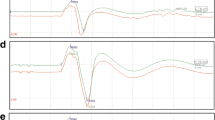Abstract
Purpose
To investigate the within 3 days effects of carotid endarterectomy (CEA) on functional status of the central motor system in patients with carotid stenosis by means of transcranial magnetic stimulation (TMS).
Patients and method
We studied 30 consecutive patients, 20 males and 10 females with a mean age of 69.2 ± 7.1 years, who underwent CEA for symptomatic carotid stenosis. All patients had suffered an ischemic attack 6 months prior to the operation. Two TMS studies, one before and one shortly after CEA were performed on both sides in each of the patients. Resting motor threshold, motor evoked potentials (MEP) amplitude at rest, MEP latency at rest and during contraction and silent period duration (SPD) were recorded and analyzed. Two groups of data were collected. Group 1 consisted of data from the operated side in all 30 patients. Group 2 consisted of data from the contralateral side and served as a control.
Results
Motor resting thresholds were similar in the two groups. Intragroup pre and post CEA comparisons showed no difference in the operated group and significant increased threshold after CEA on the non-operated side. There was no significant difference of TMS intensity for maximal MEP in either side before or after CEA. Latency at rest and during voluntary contraction and amplitude at rest showed no significant differences between or within groups’ comparisons. In group 1 SPD showed a statistically significant increase after CEA as opposed to baseline. In group 2 SPD showed a non significant increase after CEA.
Conclusion
In the absence of other MEP changes, our finding of prolonged SPD post–operatively suggests preferential influence of the inhibitory cortical circuits. The potential favorable effect of CEA in patients with hyperexcitability such as disabling spasticity after stroke should be further studied.
Similar content being viewed by others
References
Ahonen JP, Jehkonen M, Dastidar P, et al. (1998) Cortical silent period evoked by transcranial magnetic stimulation in ischemic stroke. Electroenceph Clin Neurophysiol 109:224–229
Catano A, Houa M, Noël P (1997) Magnetic transcranial stimulation: dissociation of excitatory and inhibitory mechanisms in acute strokes. Electroenceph Clin Neurophysiol 105:29–36
Chistyakov AV, Soustiel JF, Hanfer H, et al. (2001) Excitatory and inhibitory corticospinal responses to transcranial magnetic stimulation in patients with minor to moderate head injury. J Neurol Neurosurg Psychiatry 70:580–587
Chroni E, Lekka NP, Tsoussis I, et al. (2002) Effect of exercise on motor evoked potentials elicited by transcranial magnetic stimulation in psychiatric patients. J Clin Neurophysiol 19(3):240–244
Currà A, Modugno N, Inghilleri M, et al. (2002) Transcranial magnetic stimulation techniques in clinical investigation. Neurology 59:1851–1859
Dachy B, Biltiau E, Bouillot E, et al. (2003) Facilitation of motor evoked potentials in ischemic stroke patients: prognostic value and neurophysiologic correlations. Clin Neurophysiol 114(12):2370–2375
European Carotid Surgery trialists’ collaborative group (1998) Randomized trial of endarterectomy for recently symptomatic carotid stenosis: final results of the MRC European carotid Surgery Trial (ECST). Lancet 351:1379–1387
Hendrikse J, Rutgers DR, Klijn CJM, et al. (2003) Effect of carotid endarterectomy on primary collateral blood flow in patients with severe carotid artery lesions. Stroke 34:1650–1654
Inghilleri M, Berardelli A, Cruccu G, Manfredi M (1993) Silent period evoked by transcranial magnetic stimulation of the human motor cortex and cervicomedullary junction. J Physiol 466:521–534
Kessler KR, Schnitzler A, Classen J, Benecke R (2002) Reduced inhibition within primary motor cortex in patients with post-stroke focal motor seizures. Neurology 59:1028–1033
Kluytmans M, van der Grond J, Eikelboom BC, Viergever MA (1998) Longterm hemodynamic effects of carotid endarterectomy. Stroke 29:1567–1572
North American Symptomatic Carotid Endarterectomy Trial Collaborators (1991) Beneficial effect of carotid endarterectomy in symptomatic patients with high grade carotid stenosis. N Engl J Med 325:445–453
Palliyath S (2000) Role of central conduction time and motor evoked response amplitude in predicting stroke outcome. Electromyogr Clin Neurophysiol 40(5):315–320
Russell D, Dybevold S, Kjartansson O, et al. (1990) Cerebral vasoreactivity and blood flow before and 3 months after carotid endarterectomy. Stroke 21:1029–1032
Uozumi T, Ito Y, Tsuji S, Murai Y (1992) Inhibitory period following motor potentials evoked by magnetic cortical stimulation. Electroenceph Clin Neurophysiol 85(4):273–279
Ziemann U (2004) TMS and drugs. Clin Neurophysiol 115(8):1717–1729
Author information
Authors and Affiliations
Corresponding author
Rights and permissions
About this article
Cite this article
Katsoulas, G., Tsolakis, I., Argyriou, A.A. et al. Effects of carotid endarterectomy on motor evoked potentials elicited by transcranial magnetic stimulation. J Neurol 252, 1050–1054 (2005). https://doi.org/10.1007/s00415-005-0813-0
Received:
Revised:
Accepted:
Published:
Issue Date:
DOI: https://doi.org/10.1007/s00415-005-0813-0




